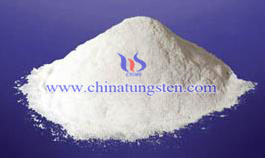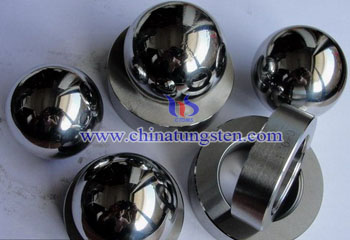Seismic Tungsten-rhenium Wire Production
- Details
- Category: Tungsten Information
- Published on Friday, 05 February 2016 11:23
- Written by yiping
- Hits: 248
Tungsten wire in the field of lighting systems are the most widely used, but to be applied to aircraft, ships and cars lights and other special lighting systems and as high precision gas chromatograph thermal conductivity wire, kinescope wire, UHF tube filament and thermocouple wire need to produce tungsten wire with more favorable properties. The experiment found that tungsten powder further doping rhenium on the basis of doped K, Si, and Al to produce tungsten-rhenium wire has good performance. Tungsten-rhenium wire not only maintain a high temperature sag resistance and improved tungsten room temperature shaping process, thereby improving the seismic performance of the tungsten wire.
Rhenium is a rare metal. At room temperature, it is grayed and crystal structure is sixty thousand close-packed. Its physical properties are as follows: Density: 21.04g / cm3; Melting point: 3180 ℃, the melting point of rhenium only lower than tungsten; boiling point: 5627 ℃; insoluble in hydrochloric acid and hydrofluoric acid. Rhenium is kind of ductility metal at room temperature which is easily formed into a sheet or wire, and the more purity of rhenium the easier molding process. But as the temperature rises rhenium will occurs work hardening in varying degrees, making it difficult to process deformation at high temperature. Therefore, as the additive element adding in tungsten wire can improve the high temperature sag resistance and shaping process at room temperature.
Tungsten-rhenium wire production processes:
1. Adding Si, Al, K and ammonium perrhenate (NH4Re4O) solution into tungsten trioxide (WO3), then after evaporation, drying, sieving, hydrogen reduction and other processes produce rhenium tungsten mixed powder. The doping mode will chose wet doping, because the wet doping can make more uniform distribution of rhenium in the tungsten-based. At the same time compared the effects of different content of rhenium doped on tungsten found rhenium added in an amount of 3% can produce more favorable performance tungsten-rhenium wire.
2. The mixed powder is pressed into a tungsten-rhenium strip, obtained billet after through sintered.
3. Finally, after swaging, drawing and other processes produce tungsten-rhenium wire.
| Tungsten Supplier: Chinatungsten Online www.chinatungsten.com | Tel.: 86 592 5129696; Fax: 86 592 5129797;Email:sales@chinatungsten.com |
| Tungsten News & Prices, 3G Version: http://3g.chinatungsten.com | Molybdenum News & Molybdenum Price: http://news.molybdenum.com.cn |
Tungsten Carbide Valve Ball Description (2/2)
- Details
- Category: Tungsten Information
- Published on Thursday, 04 February 2016 17:16
- Written by xiaobin
- Hits: 230
In some deep oil well with high content of water and sand, high abrasion, the advantages of high density, excellent wear resistance and corrosion resistance of tungsten carbide valve ball becomes more obvious. Theoretically, the main failure modes include wearing, abrasion, fatigue cracks, collapse and so on, which makes the ball valve material fail earlier in oil drilling (such as bearing steel, ceramics) and shorten the service life (bearing steel is easily corroded by the liquid and has lower wear resistance; ceramics belongs to brittle materials and has lower impact ductility, which is easily to break).
Therefore, tungsten carbide valve ball makes up for the deficiency perfectly, which not only has high hardness, high density, high strength, excellent chemical stability of tungsten (W), but also remarkably improves the bending strength and impact ductility of oil drilling pump valve ball by adding cobalt (Co). Excellent resistance to wear and corrosion resistance greatly improved drilling efficiency, extend tool life, but also reduces operating costs. Recent years, the related researchers and scholars will further shift the focus to the cemented carbide valve ball, especially in the United States and some European industrial countries, tungsten carbide valve ball has been increasingly widely used, the type and quantity are continuing to increase, and toward the high temperature and pressure, high tightness, large-caliber, long service life and multifunction developing. The reliability and overall performance have reached a higher level, has been replaced with a valve part, control valve and end valve. In addition, with the innovation of tungsten carbide valve ball technology, it has a broader applying prospect in oil and gas pipelines, refinery cracker and nuclear industry, especially in medium and large caliber, medium and high pressure fields.
| Tungsten Carbide Supplier: Chinatungsten Online tungsten-carbide.com.cn | Tel.: 86 592 5129696; Fax: 86 592 5129797;Email:sales@chinatungsten.com |
| Tungsten News&Tungsten Prices, 3G Version: http://3g.chinatungsten.com | Molybdenum News & Molybdenum Price: http://news.molybdenum.com.cn |
Ammonium Paratungstate as Raw Material for Preparing Ammonium Metatungstate 2/2
- Details
- Category: Tungsten Information
- Published on Thursday, 04 February 2016 16:39
- Written by chunyan
- Hits: 235
Ion exchange method, specific steps are carried out as follows:
1. Heating ammonium paratungstate(APT) to 130~140℃, and keep the temperature for 1~8 hours;
2. Transfer the formation of step 1 into slurry, and boiled to 80~100℃ for 2~6 hours to form ammonium metatungstate (AMT) solution;
3. Concentrate and crystallization, filtrate to separation, and then dry to get AMT crystal.

Electrodialysis method, the implementation steps are as follows:
1. Add APT into the anode chamber, and electrify;
2. When the electricity passes by, the ammonium ions go into the cathode chamber through the anion exchange membrane, and the concentration of AMT ion in the anode chamber increases;
3. Release the AMT solution from the cathode chamber;
4. Concentrate and crystallization, filtrate to separation, and then dry to get AMT crystal.
Shallow thermal decomposition - resin exchange method, the steps are as follows:
1. Place the APT in the enamel plate, and put them in a constant temperature oven at 240℃ heated for 25~30 minutes;
2. Remove the reactants, slowly pour into pure water of 95℃ with stirring;
3. Add L type resin when the majority of solid is dissolved, control pH value between 3~4, and stir for 30min in an environment of constant temperature;
4. Filter he mixture through a stainless steel screen to remove resin and debris;
5. Lay aside the filtrate for 12 hours, then vacuum filtration to remove insoluble impurities and tungsten compounds;
6. Heat and condense to crystallization, and drying by 50-60℃ air for 2 hours to obtain AMT crystal.
| APT Supplier: Chinatungsten Online ammonium-paratungstate.com | Tel.: 86 592 5129696; Fax: 86 592 5129797;Email:sales@chinatungsten.com |
| Tungsten News&Tungsten Prices, 3G Version: http://3g.chinatungsten.com | Molybdenum News & Molybdenum Price: http://news.molybdenum.com.cn |
Tungsten Carbide Valve Ball Description (1/2)
- Details
- Category: Tungsten Information
- Published on Thursday, 04 February 2016 17:14
- Written by xiaobin
- Hits: 241
Tungsten carbide valve ball or called tungsten carbide ball valve is converted from conventional stopcock. It uses a ball to start and stop by sphere running around the stem axis. Compared with conventional valve, valve ball has many advantages, such as simple structure, excellent tightness, light in weight, lower material consumption, smaller installation size, smaller volume within a certain nominal diameter, smaller driving moment and easy operation for controlling, which becomes one of the most rapid developing of valve gradually in recent years. Tungsten carbide ball valve in the pipe main role is cut off, distribution and change the direction of media flow, other special designed ball valve structure can achieve flow adjustment function.
Tungsten carbide ball (WC-Co) with high precision we discuss here has been widely used in valve ball and ball seat for oil drilling, deep-sea drilling, which is also the most critical component of oil pump. Due to the harsh conditions in oil drilling industry, especially in some sand drain, heavy oil well, high pressure oil well, which contains water, diverse gas, wax, sand and some materials with high corrosivity, the pump need to pump oil from hundreds or even thousands of meters of strata extracted. It requires that the ball valve and ball seat has excellent tightness, wear resistance and corrosion resistance (pumping the ball, with rear seat evacuated to an absolute pressure 0.36kgN / cm2 or less, in the 10s the absolute pressure values do not change).

| Tungsten Carbide Supplier: Chinatungsten Online tungsten-carbide.com.cn | Tel.: 86 592 5129696; Fax: 86 592 5129797;Email:sales@chinatungsten.com |
| Tungsten News&Tungsten Prices, 3G Version: http://3g.chinatungsten.com | Molybdenum News & Molybdenum Price: http://news.molybdenum.com.cn |
Ammonium Paratungstate as Raw Material for Preparing Ammonium Metatungstate 1/2
- Details
- Category: Tungsten Information
- Published on Thursday, 04 February 2016 16:32
- Written by chunyan
- Hits: 235
Ammonium metatungstate (AMT) is an important intermediate product of tungsten metallurgy, a white crystal or yellow powder which is easy to dissolve in water, but insoluble in alcohol. AMT can be used in preparing tungsten, alloy steel, fire proof fabric, etc. and also be used for ceramic industry. It’s also used in the manufacture of various petrochemical catalysts and other tungsten compounds which is the raw material of catalysts based on tungsten. There are many ways to generate AMT, such as tungstate, ion exchange, thermal decomposition method and so on. This paper, we would like to introduce some methods that preparing AMT base on material of ammonium metatungstate (APT).
Neutralization method – take APT and nitric acid as raw materials to generate AMT, the specific steps are as follows:
1. Add ionized water n and citric acid into APT to form a mixture that concentration of WO3 12% ~ 30%;
2. According to the ratio of APT: nitric acid equals to 1:20, adding nitric acid which the concentration is 3% to 5% into APT slurry;
3. Control solid-liquid ratio at 1: (3~4), and pH controlled in 2~4, heating and dissolve to make the relative density of the solution about 1.18~1.20. Then heated to 80~90℃, keep the temperature and pH value constantly, stir for 4h, aging for several hours;
4. Concentrate the solution until the WO3 content is about 50%, filtering to remove the insoluble substance, and keep concentrating, then cooling down to 80℃ and drying get AMT.
| APT Supplier: Chinatungsten Online ammonium-paratungstate.com | Tel.: 86 592 5129696; Fax: 86 592 5129797;Email:sales@chinatungsten.com |
| Tungsten News&Tungsten Prices, 3G Version: http://3g.chinatungsten.com | Molybdenum News & Molybdenum Price: http://news.molybdenum.com.cn |





 sales@chinatungsten.com
sales@chinatungsten.com